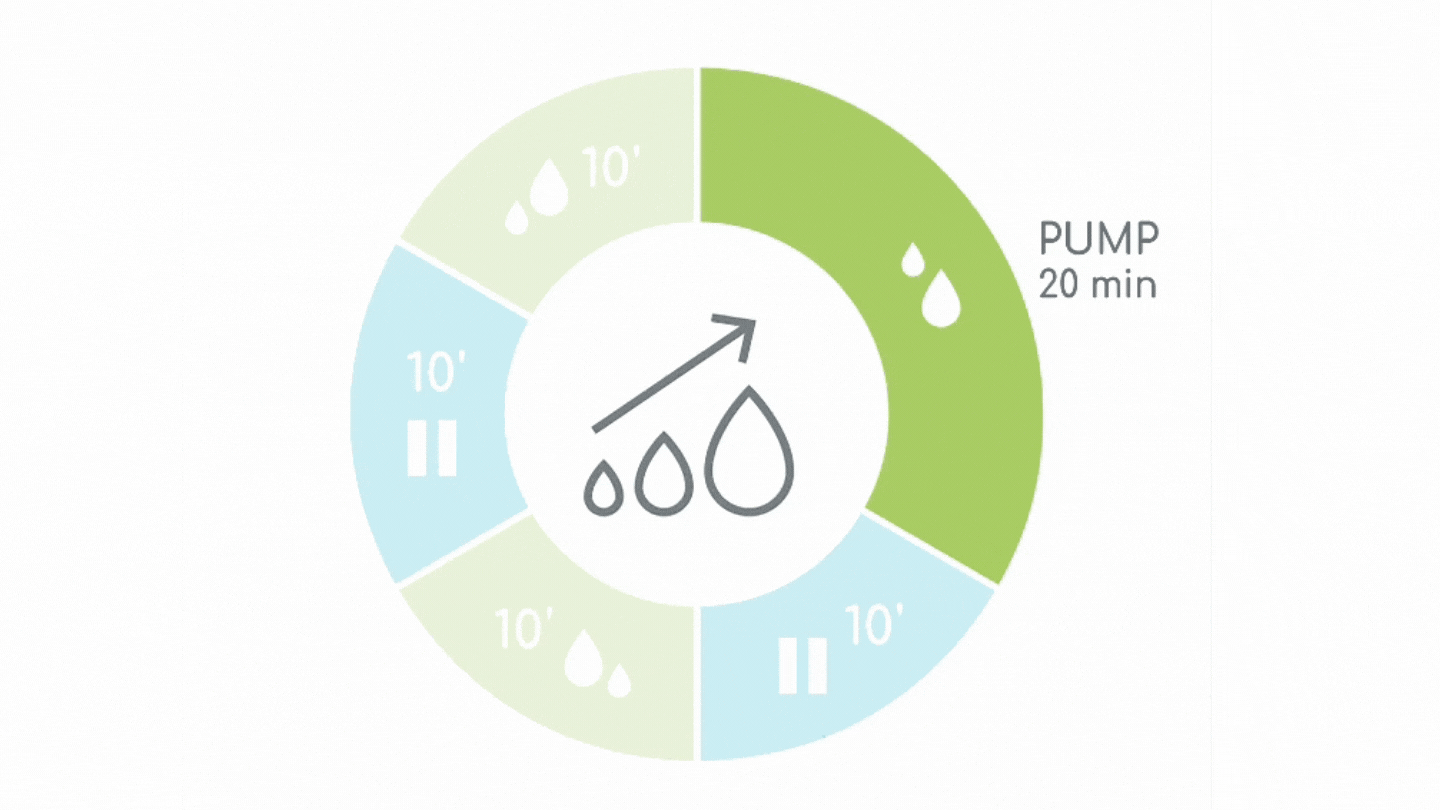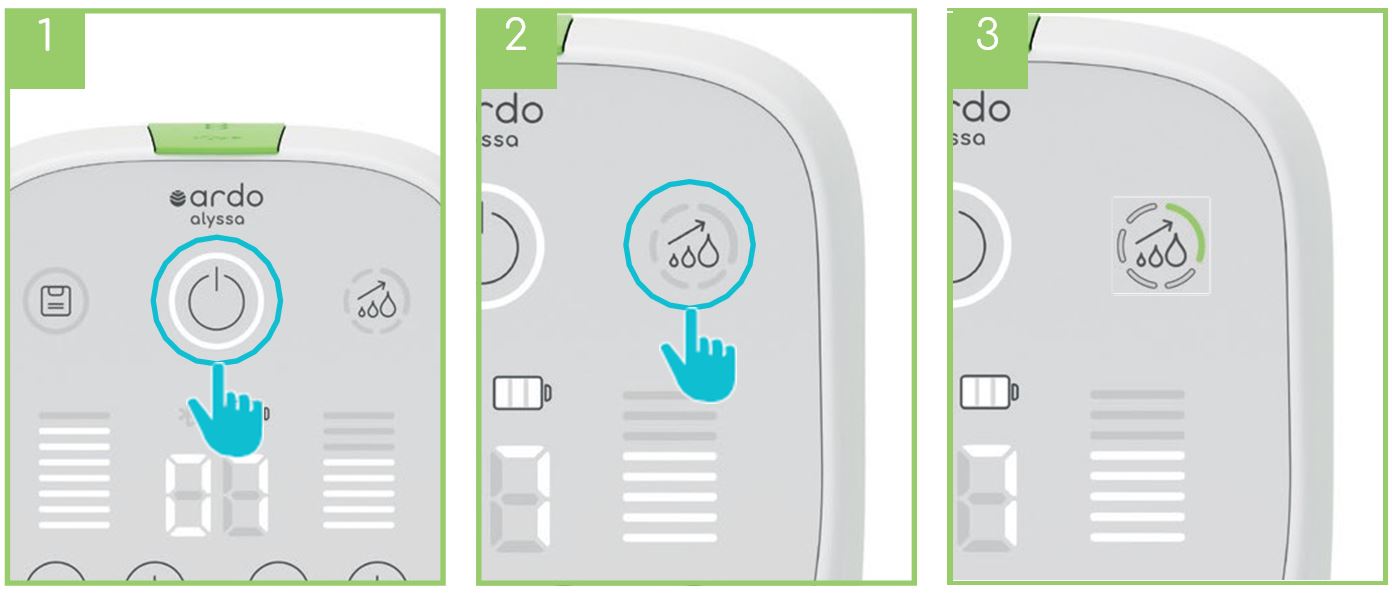
Power Pumping is based on cluster feeding
Cluster feeding is a baby’s breastfeeding behavior that increases the milk volume by more frequently sucking at the breast(1). The term is derived from the grouping of feeds close together.
There are periods when babies want to be breastfed more often, interrupted by short breaks – usually in the early evening over 2–3 hours. This natural breastfeeding pattern ensures that the prolactin level (prolactin = milk-producing hormone) stays high or is increased between the feeding phases, which leads to an overall increase in the milk volume(2).
The Power Pumping method
Power pumping is based on the periodic frequent breastfeeding with short pauses between feeds. The process signals to the breast to produce more milk to meet the baby’s demands. Power Pumping also makes use of the fact that considerably more milk flows with the first let-down reflex than during the subsequent flows of milk, regardless of the level of the vacuum(3). This means that repeated pumping over an hour with pauses in between triggers a new milk let-down reflex with each pumping sequence, meaning that larger volumes of breast milk are available respectively larger volumes can be pumped4. The Power Pumping method is therefore recommended by lactation specialists to improve milk production or to stabilize fluctuating milk volumes(5,6,7).
The process of power pumping can be overwhelming, especially when juggling a new baby. Mothers are tasked with following a series of complicated pumping session, involving pumping for 20 minutes, resting for 10 minutes, pumping for 20 minutes, and so on…This can definitely be stressful for an already sleep deprived mom.
Ardo Alyssa automatic Power Pumping
The automatic Power Pumping function of Ardo Alyssa eliminates the confusion of power pumping. With the push of a button, the Alyssa breast pump takes over the entire power pumping session.
The Power Pumping function is a predefined one-hour interval consisting of three pumping phases interrupted by two pauses that mimics a baby’s cluster feeding. This feature makes use of the physiology of the milk let-down reflex to increase the milk volume and increase the pumped milk volume.
While the duration of the pumping phases and the pauses are predefined, the mother can adjust the vacuum and cycle settings in both the stimulation and pumping modes to satisfy her own needs at any time. Ardo Alyssa simplifies the process of Power Pumping to increase the milk volume, helping to make power pumping a success.
When is the Alyssa’s automatic Power Pumping useful?
Using the automatic Power Pumping function is generally useful to increase the milk volume and stabilize fluctuating milk volumes. Below are a few concrete examples of the use of the Alyssa Power Pumping function:
- The mother is producing too little milk to feed her baby exclusively with breast milk.
- The baby is having a growth or development spurt and the current milk volume is insufficient.
- To build up milk reserves if the mother is working again or would like to pursue a hobby.
- If too little milk is produced due to stress or irregular pumping or not pumping often enough.
- To maintain the milk volume for mothers with very premature babies who cannot yet suckle at the breast.
- For babies who are too weak to suckle or are separated from their mothers.
- With a decline in the volume of breast milk in premenstrual women.
Using Alyssa’s automatic Power Pumping function
The automatic Power Pumping function follows the defined pumping–pause sequence(7,9):
- 20 minutes pumping
- 10 minutes pause
- 10 minutes pumping
- 10 minutes pause
- 10 minutes pumping
It is very easy to use the automatic Power Pumping function:
- Switch on Ardo Alyssa.
- Tap the automatic Power Pumping button to start the one-hour program and to start the pumping.
- After every pause, activate the Power Pumping again using the Power Pumping button.
During the pumping phases, it is possible to adjust the vacuum and cycle settings at any time to suit individual needs.

Information on the step-by-step procedure is included in the instructions for use:
- The automatic Power Pumping is used in addition to the established breastfeeding or pumping routines.
- Milk production is increased when Power Pumping is used 1 to 2 times a day for 3 to 4 days or longer. For many women a significant increase in milk production is seen within three days while for others the maximum effect of the increase is achieved between four and fourteen days. It may be that in the first few days only a few drops of milk can be pumped. If the Power Pumping is continued and the breast regularly stimulated, the milk volume will increase.
- The automatic Power Pumping can be used throughout breastfeeding.
- While the duration of the pumping phases and the pauses are predefined, the mother can adjust the vacuum and cycle settings to her own needs at any time.
- The guideline for the vacuum level is personal well-being and not the maximum vacuum that can be set. With a comfortable level, the milk will flow better and the nipples will remain intact.
Practical Tips
- Double pumping with the automatic Power Pumping is highly recommended because it helps to further increase the milk volume8.
- Hands-free pumping by wearing a pumping bra gives greater freedom. A pumping bra can be
purchased or easily made at home:
1. Put on an old, elastic bra
2. Mark the level of your nipples
3. Take the bra off
4. On each side cut out a small cross with scissors
5. Attach the breast shell to the bra and start pumping - The 10 minute pause can be used, for example, to drink something, eat a snack, shower, read, listen to music, do a chore around the house or simply enjoy a pleasant break.
- Massaging the breast or applying heat with a warm wrap before pumping can help to gently prepare the breast.
- A breast massage during pumping can improve the milk flow and also help to increase the milk
volume (hands-on pumping)(10).
Different information in the specialist literature
There are different models described in the literature for the sequence of Power Pumping and
sometimes Power Pumping is also called cluster pumping.
In recent years, one-hour Power Pumping 20-10-10-10-10 with 3 pumping phases interrupted by 2 pauses has become firmly established, as shown by internet searches. For this reason, the automatic Power Pumping of Ardo Alyssa follows this sequence.
References
1. Katharine R. Faulkner: Modeling milk production in the lactating period and the effect of feeding frequency on milk production, The university of British Columbia (2019)
2. Arnold LDW: Human Milk in the NICU: Policy Into Practice, Jones and Barlett Publishing, 2010; 143 -144).
3. Ramsey et al: Milk flow rates can be used to identify and investigate milk ejection in women expression breast milk using an electric breast pump. Breastfeeding Medicine 2006, 14 -23.
4. Walker M: Clinics in Human Lactation – Pumps and Pumping Protocols, Hale Publishing 2012; 67
5. Walker M: Breastfeeding Management for the Clinician – Using the evidence. 4. Edition, Jones and Barlett Publishing, 2017; 444 – 445
6. Europäisches Institut für Stillen und Laktation (EISL): Skriptum «Gewinnen von Muttermilch per Hand und Milchpumpe. 2018
7. Andrea Hemmelmayr IBCLC, Laktation und Stillen 4-2016 HANDOUT, “Power Pumping” Superantrieb für die Milchproduktion. www.elacta.eu
8. Prime DK et al. Simultaneous breast expression in breastfeeding women is more efficacious than sequential breast expression. Breastfeed Med. 2012 Dec;7(6):442-447.
9. https://livingwithlowmilksupply.com/power-pumping-to-increase-milk-supply 08.2021
10. Morton, J., Hall, J. Y., Wong, R. J., Thairu, L., Benitz, W. E., & Rhine, W. D. (2009). Combining hand techniques with electric pumping increases milk production in mothers of preterm infants. Journal of Perinatology, 29(11), 757-764.
